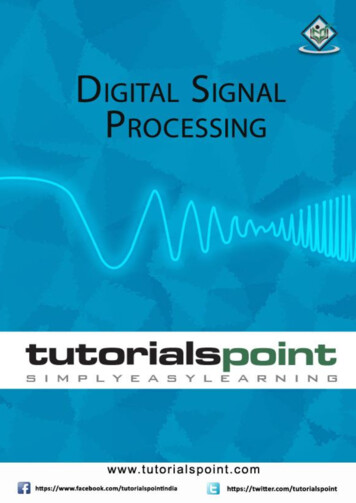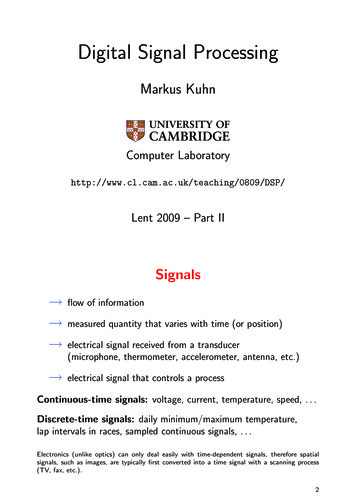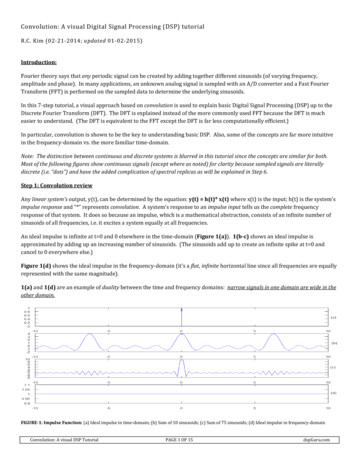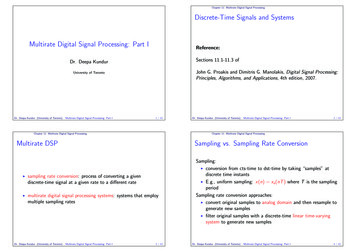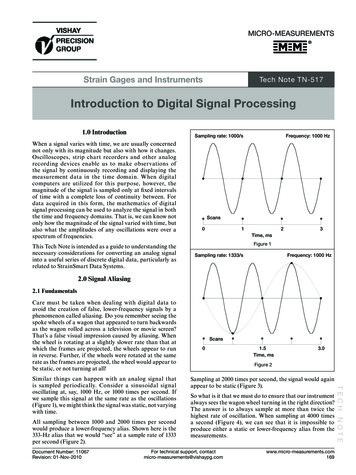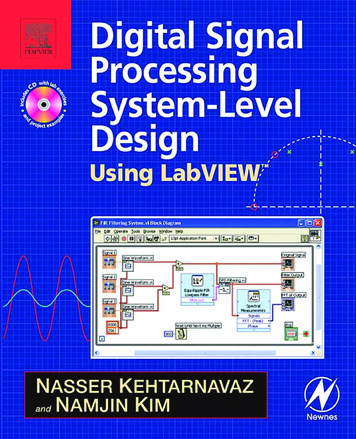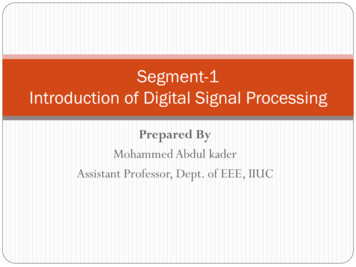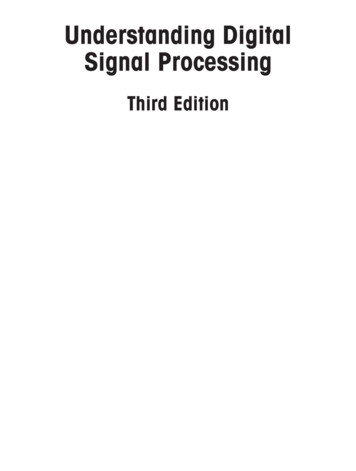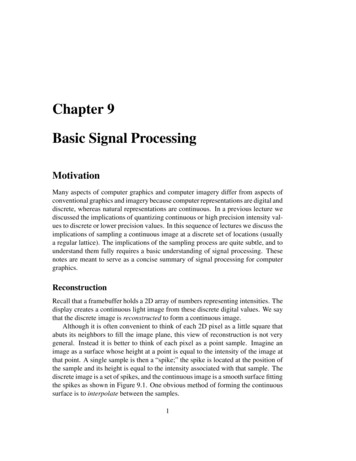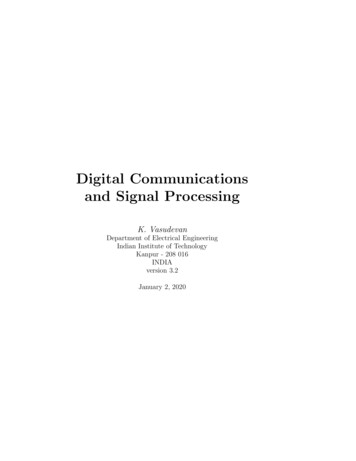
Transcription
Digital Communicationsand Signal ProcessingK. VasudevanDepartment of Electrical EngineeringIndian Institute of TechnologyKanpur - 208 016INDIAversion 3.2January 2, 2020
iiK. Vasudevan Faculty of EE IIT Kanpur India email: vasu@iitk.ac.inDigital Communications and Signal Processingc 2001-present K. Vasudevan. All rights reserved. No part of thisbook may be reproduced without prior permission from the author.This book is set in LATEX
To my family
AcknowledgementsDuring the course of my master’s degree and PhD at IIT Madras, I had theopportunity to learn the fundamental concepts of digital communications frommy instructors, Dr. V. G. K. Murthy, Dr. V. V. Rao, Dr. K. RadhakrishnaRao, Dr. Bhaskar Ramamurthi and Dr. Ashok Jhunjhunwalla. It is a pleasureto acknowledge their teaching. I also gratefully acknowledge the guidance ofDr. K. Giridhar and Dr. Bhaskar Ramamurthi who were jointly my Doctoralsupervisors. I also wish to thank Dr. Devendra Jalihal for introducing me tothe LATEX document processing system without which this book would not havebeen complete. I would like to express my gratitude to my instructors at IITKharagpur (where I had completed my undergraduate) – Dr. S. L. Maskara,Dr. T. S. Lamba, Dr. R. V. Rajkumar and Dr. S. Shanmugavel (now withAnna University, Chennai). I thank Dr. Surendra Prasad of IIT Delhi and Dr.P. Y. Kam of the National University of Singapore for encouraging me to writethis book.During the early stages of my career (1991-1992), I was associated with theCAD-VLSI Group, Indian Telephone Industries Ltd., at Bangalore. I would liketo express my gratitude to Mr. K. S. Raghunathan (formerly a Deputy ChiefEngineer at the CAD-VLSI Group), for his supervision of the implementationof a statistical fault analyzer for digital circuits. It was from him that I learntthe concepts of good programming, which I cherish and use to this day.Special mention is also due to Dr. Bixio Rimoldi of the Mobile Communications Lab, EPFL Switzerland and Dr. Raymond Knopp, now with InstituteEurecom, Sophia Antipolis France, for providing me the opportunity to implement the signal processing algorithms discussed in Chapter 4, in real-time, fortheir software radio platform.I would like to thank many of my students for their valuable feedback onthe first edition of this book. Finally, I thank my colleagues at IIT Kanpur,in particular Dr. S. C. Srivastava, Dr. V. Sinha (now retired from IITK), Dr.Govind Sharma, Dr. Pradip Sircar, Dr. R. K. Bansal, Dr K. S. Venkatesh andDr. A. K. Chaturvedi, for their support and encouragement. Thanks are alsodue to the Open Source community for providing operating systems like Linuxand software like Scilab, LATEX, Xfig and Gnuplot, without which this bookwould not have been complete. I also wish to thank the publisher, Mr. MadhuReddy and the editor Ms. Sreelatha Menon for their skill and dedication inbringing out the third edition of this book.In spite of my best efforts, some errors might have gone unnoticed. Suggestions for improving the book are welcome.K. VasudevanAugust 2012
Notation{A} \ {B}a {A}a / {A}a ba bElements of set A minus set B.a is an element of set A.a is not an element of set A.Logical AND of a and b.Logical OR of a and b. Equal to by definition.Convolution.Dirac delta function.Kronecker delta function.A complex quantity.Estimate of x.A vector or matrix.An M M identity matrix.Complex symbol (note the absence of tilde).Real part.Imaginary part.Real or in-phase part of x̃.Imaginary or quadrature part of x̃.Expectation.Complementary error function.Closed interval, inclusive of x1 and x2 .Open interval, inclusive of x1 and exclusive of x2 .Open interval, exclusive of x1 and x2 .Probability.Probability density function.Frequency in Hertz.With respect to.?a b ! ⌊x⌋⌈x⌉j δD (·)δK (·)x̃x̂xIMSℜ{·}ℑ{·}xIxQE[·]erfc(·)[x1 , x2 ][x1 , x2 )(x1 , x2 )P (·)p(·)Hzwrta may or may not be equal to b.There exists.There exists uniquely.Does not exist.For all.Largest integer less than or equal to x.Smallestinteger greater than or equal to x. 1
Calligraphic RSTUVWXYZ
ContentsPreface to the Second EditionxiPreface to the Third EditionxiiList of Programsxiii1 Introduction1.1 Overview of the Book . . . . . . . . . . . . . . . . . . . . . . . .1.2 Bibliography . . . . . . . . . . . . . . . . . . . . . . . . . . . . .2 Communicating with Points2.1 Coherent Detectors for 2D Constellations . . . . . . . . . . .2.1.1 Performance Analysis . . . . . . . . . . . . . . . . . .2.1.2 Optimizing the Constellation . . . . . . . . . . . . . .2.1.3 Union Bound on the Probability of Error . . . . . . .2.1.4 M -ary Signalling Schemes . . . . . . . . . . . . . . . .2.1.5 Constellations with Minimum Average Power . . . . .2.1.6 Analysis for Non-Equiprobable Symbols . . . . . . . .2.2 Coherent Detectors for Multi-D Orthogonal Constellations . .2.2.1 Performance Analysis . . . . . . . . . . . . . . . . . .2.2.2 Union Bound on the Probability of Error . . . . . . .2.2.3 Minimum SNR Required for Error-free Transmission .2.2.4 Binary Antipodal and Orthogonal Constellations . . .2.3 Bi-Orthogonal Constellations . . . . . . . . . . . . . . . . . .2.4 Simplex Constellations . . . . . . . . . . . . . . . . . . . . . .2.5 Noncoherent Detectors for Multi-D Orthogonal Constellations2.5.1 Performance Analysis . . . . . . . . . . . . . . . . . .2.5.2 Exact Expression for Probability of Error . . . . . . .2.6 Noncoherent Detectors for M -ary PSK . . . . . . . . . . . . .2.6.1 Approximate Performance Analysis . . . . . . . . . . .2.7 Coherent Detectors in Coloured Noise . . . . . . . . . . . . .2.7.1 Performance Analysis . . . . . . . . . . . . . . . . . .2.7.2 Predictive VA for Channel Coded Symbols . . . . . .2.8 Coherent Detectors for Flat Fading Channels . . . . . . . . .1579911131314252628303233414243434547505154576163
viiiK. Vasudevan Faculty of EE IIT Kanpur India email: vasu@iitk.ac.in2.8.1 Performance Analysis . . . . . . . . . . . . . . . .2.8.2 Performance Analysis for BPSK . . . . . . . . . .2.8.3 Approximate Performance Analysis . . . . . . . . .2.8.4 Multiple Input Multiple Output (MIMO) Systems2.9 Differential Detectors for Flat Fading Channels . . . . . .2.10 Summary . . . . . . . . . . . . . . . . . . . . . . . . . . 01431471521591611641711734 Transmission of Signals through Distortionless Channels4.1 Linear Modulation . . . . . . . . . . . . . . . . . . . . . . .4.1.1 Transmitter . . . . . . . . . . . . . . . . . . . . . . .4.1.2 Power Spectral Density of the Transmitted Signal .4.1.3 Proof of Proposition 3.0.1 . . . . . . . . . . . . . . .4.1.4 Receiver . . . . . . . . . . . . . . . . . . . . . . . . .4.1.5 Pulse Shapes with Zero ISI . . . . . . . . . . . . . .4.1.6 Application of Matched Filtering in CDMA . . . . .4.1.7 Discrete-Time Receiver Implementation . . . . . . .4.2 Carrier and Timing Synchronization . . . . . . . . . . . . .4.2.1 Data-Aided Carrier Phase Estimation . . . . . . . .4.2.2 Non-Data-Aided Carrier Phase Estimation . . . . .4.2.3 Error-Rate Analysis . . . . . . . . . . . . . . . . . .4.2.4 Data-Aided Timing Synchronization . . . . . . . . .4.2.5 Results for Synchronization . . . . . . . . . . . . . .4.3 Non-Linear Modulation . . . . . . . . . . . . . . . . . . . .4.3.1 CPFM with Full Response Rectangular Filters . . 313 Channel Coding3.1 The Convolutional Encoder . . . . . . . . . . . . . . . .3.2 Are the Encoded Symbols Correlated? . . . . . . . . . .3.3 Hard Decision Decoding of CC . . . . . . . . . . . . . .3.3.1 The Viterbi Algorithm (VA) . . . . . . . . . . .3.3.2 Performance Analysis of Hard Decision Decoding3.4 Soft Decision Decoding of CC . . . . . . . . . . . . . . .3.4.1 Performance Analysis of Soft Decision Decoding3.5 Trellis Coded Modulation (TCM) . . . . . . . . . . . . .3.5.1 Mapping by Set Partitioning . . . . . . . . . . .3.5.2 Performance of TCM Schemes . . . . . . . . . .3.5.3 Analysis of a QPSK TCM Scheme . . . . . . . .3.5.4 Analysis of a 16-QAM TCM Scheme . . . . . . .3.6 Maximization of the Shape Gain . . . . . . . . . . . . .3.7 Constellation Shaping by Shell Mapping . . . . . . . . .3.7.1 The Shell Mapping Algorithm . . . . . . . . . . .3.8 Turbo Codes . . . . . . . . . . . . . . . . . . . . . . . .3.8.1 The Turbo Decoder . . . . . . . . . . . . . . . .3.8.2 The BCJR Algorithm . . . . . . . . . . . . . . .3.8.3 Performance of ML Decoding of Turbo Codes . .3.9 Summary . . . . . . . . . . . . . . . . . . . . . . . . . .
K. Vasudevan Faculty of EE IIT Kanpur India email: vasu@iitk.ac.in4.4ixSummary . . . . . . . . . . . . . . . . . . . . . . . . . . . . . . . 2465 Transmission of Signals through Distorting Channels5.1 Receivers Based on Equalization . . . . . . . . . . . . . . .5.1.1 Linear Equalization – Symbol-Spaced Equalizers . .5.1.2 Finite Length Equalizer . . . . . . . . . . . . . . . .5.1.3 The Steepest Descent Algorithm . . . . . . . . . . .5.1.4 The Least Mean Square (LMS) Algorithm . . . . . .5.1.5 Linear Equalization – Fractionally-Spaced Equalizers5.1.6 Non-Linear Equalization – The Predictive DFE . . .5.1.7 Implementation of the Predictive DFE . . . . . . . .5.1.8 The Conventional DFE . . . . . . . . . . . . . . . .5.2 Receivers Based on MLSE . . . . . . . . . . . . . . . . . . .5.2.1 Symbol-Spaced MLSE . . . . . . . . . . . . . . . . .5.2.2 Fractionally-Spaced MLSE . . . . . . . . . . . . . .5.2.3 T -spaced and T /2-spaced ML Detectors . . . . . . .5.3 Multicarrier Communication . . . . . . . . . . . . . . . . . .5.3.1 Channel Loading . . . . . . . . . . . . . . . . . . . .5.3.2 The Discrete Multitone (DMT) . . . . . . . . . . . .5.4 Summary . . . . . . . . . . . . . . . . . . . . . . . . . . . 03307A Complex Differentiation309B The Chernoff Bound311C On Groups and Finite FieldsC.1 Groups . . . . . . . . . . . . . .C.2 Fields . . . . . . . . . . . . . .C.2.1 The D-Transform . . . .C.2.2 Polynomials over GF(2).D Properties of the Autocorrelation MatrixE Some Aspects of Discrete-Time SignalE.1 The Sampling Theorem . . . . . . . .E.2 Sampling Rate Conversion . . . . . . .E.2.1 Decimation by D . . . . . . . .E.2.2 Upsampling by I . . . . . . .E.3 Discrete-Time Matched Filtering . . .Processing. . . . . . . . . . . . . . . . . . . . . . . . . . . . . . . . . . . .314314318320322324.328328333333335336F The Root Raised Cosine Pulse340G Parseval’s Energy Theorem343H Transmission of a Random Process Through a Filter345I347Lowpass Equivalent Representation of Passband Systems
xK. Vasudevan Faculty of EE IIT Kanpur India email: vasu@iitk.ac.inJ Linear PredictionJ.1 Forward Prediction . . . . . . . . . . . . . . . . . . . . . . .J.2 Backward Prediction . . . . . . . . . . . . . . . . . . . . . .J.3 The Levinson Durbin Algorithm . . . . . . . . . . . . . . .J.4 Minimum Phase Property of the Forward Prediction FilterJ.5 Cholesky Decomposition of the Autocovariance Matrix . . .351351353355361366K Eigendecomposition of a Circulant Matrix368L The Channel Capacity Theorem371
Preface to the SecondEditionThe second edition of this book is a result of the continuing efforts of the authorto unify the areas of discrete-time signal processing and communication. The useof discrete-time techniques allow us to implement the transmitter and receiveralgorithms in software.The additional topics covered in the second edition are:1. Computing the average probability of error for constellations having nonequiprobable symbols (Chapter 1).2. Performance analysis of differential detectors in Rayleigh flat fading channels (Chapter 1).3. Synchronization techniques for linearly modulated signals (Chapter 4).The additional C programs that are included in the CDROM are:1. Coherent detectors for multi-D orthogonal constellations in AWGN channels (associated with Chapter 1).2. Noncoherent detectors for multi-D orthogonal constellations in AWGNchannels (associated with Chapter 1).3. Coherent detection of M -ary constellations in Rayleigh flat fading channels(associated with Chapter 1).4. Coherent detection of QPSK signals transmitted over the AWGN channel.Here, the concepts of pulse shaping, carrier and timing synchronization areinvolved (associated with Chapter 4).Many new examples have been added. I hope the reader will find the secondedition of the book interesting.K. VasudevanJuly 2008
Preface to the ThirdEditionThe additional topics covered in the third edition are:1. MIMO systems (Chapter 2).2. Detection of coded symbols in coloured noise (Chapter 2).3. The channel capacity theorem for both AWGN and fading channels (Appendix L).Many new examples have been added. I hope the reader will find the thirdedition of the book interesting.K. VasudevanJuly 2018
List of Programs1. Associated with Chapter 2 (Communicating with Points)(a) mdcoho: Coherent detection of multidimensional orthogonal constellations in AWGN channels.(b) mdnc: Noncoherent detection of multidimensional orthogonal constellations in AWGN channels.(c) fade: Coherent detection of M-ary constellations in Rayleigh flatfading channels.2. Associated with Chapter 3 (Channel Coding)(a) hdclass: Hard decision decoding of convolutional codes using theViterbi algorithm.(b) tc12: MAP decoding of parallel concatenated turbo codes.(c) shellmap: The Shell mapping algorithm.3. Associated with Chapter 4 (Transmission of Signals through DistortionlessChannels)(a) deal1: A digital communication system employing root
opportunity to learn the fundamental concepts of digital communications from my instructors, Dr. V. G. K. Murthy, Dr. V. V. Rao, Dr. K. Radhakrishna Rao, Dr. Bhaskar Ramamurthi and Dr. Ashok Jhunjhunwalla. It is a pleasure to acknowledge their teaching. I also gratefully acknowledge the guidance of Dr. K. Giridhar and Dr. Bhaskar Ramamurthi who were jointly my Doctoral supervisors. I also wish .
